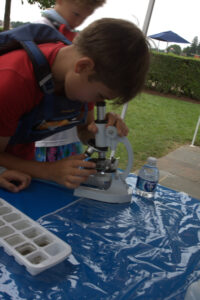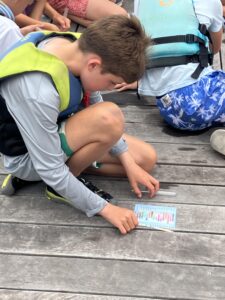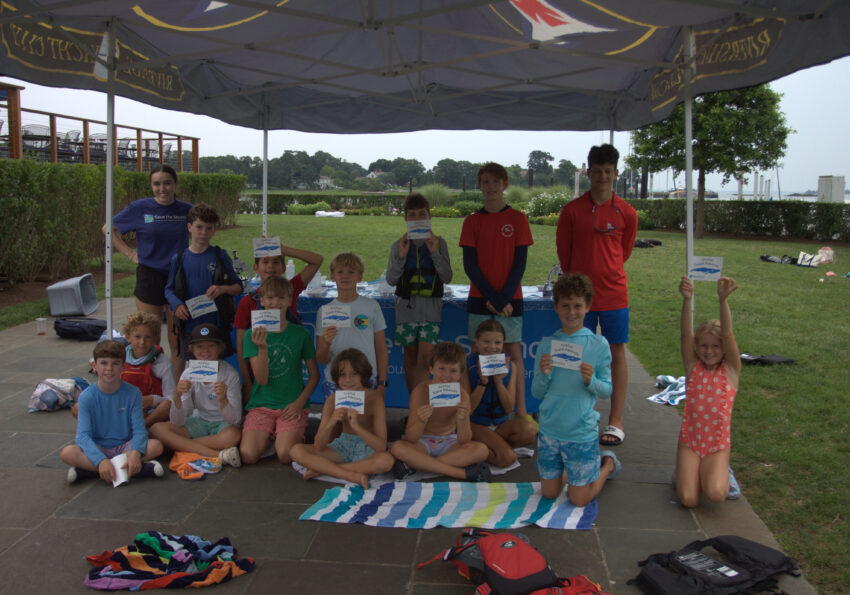Save the Sound Partnership with JSA of LIS
written by Erin Wojdaszka, JSA Communications Manager
Save the Sound and JSA of LIS presented a new initiative this summer that incorporated sailing with learning about water and the local environment. Save the Sound visited various JSA member sailing programs to teach young sailors about the Long Island Sound, environmental awareness, and how to make a difference through personal choices. 
On July 25th, I had the pleasure of joining Serena Finger at Riverside Yacht Club. Serena is an intern working with Save the Sound. She currently attends George Washington University and is studying Environmental Science. At the beginning of June, Serena had the opportunity to work with the water quality team in STS’ Larchmont NY office and Jon Vander Werff, fish biologist, to create a curriculum to teach junior sailors about their local environment. Serena said, “Once we started in June, signups started off slowly, then all of sudden at the beginning of July, we were flooded with sailing programs requesting dates. It was amazing to see how many programs were interested in what we could teach to their sailors.”
Serena shows up at the junior programs and sets up her tent, table, and equipment. Then starts out, “Have you ever wondered how the environment affects our local waterways?” She introduces the lesson to the sailors and they move to the dock to start their interactive labs. The sailors start off with measuring the water clarity using a Secchi Disk. They place the disks in the water, let them sink and then slowly pull the disk up until they see it. Then they measure how far the disk went down. This will tell them how much light can get through the water and provide nutrients to the plants and marine life. This also helps the kids see how much pollution can affect our waters and how it can block sunlight from going in the water. 
Using an EnviroScape model, we could see firsthand how runoff from the land during a rainstorm impacts the Long Island Sound. Serena explains at times, excess nutrients can cause algal blooms, which can affect the health of our waters and our local shellfish populations, like oysters and mussels. In order for the kids to see what is happening in the water, they tested the water for various elements to evaluate the health of the marine ecosystem. They used a test tube to gather a water sample, then placed a test strip in the water sample and observed how the test strip changed color based on what elements are present in the sample (for example, the pH level, chlorine level, fluoride, etc.)
 Serena then explained how runoff can also cause waterways to become murky and turbid, which can be detrimental to marine life. The kids then used a plankton tow, which is a net and a bottle, to gather more water samples. The sailors took their water samples back to Serena’s table and she taught them how to use a microscope and the parts of the microscope. The sailors placed small portions of their water sample on glass slides and looked through the microscope. It was so cool to watch the kids get excited about finding something to see in their ice cube tray samples. Charlie, a Riverside YC sailor said, “ Look there is something swimming in here, can you help me get it on my slide?” Charlie, a few other sailors and one of the coaches, all gathered around to take a look at the plankton.
Serena then explained how runoff can also cause waterways to become murky and turbid, which can be detrimental to marine life. The kids then used a plankton tow, which is a net and a bottle, to gather more water samples. The sailors took their water samples back to Serena’s table and she taught them how to use a microscope and the parts of the microscope. The sailors placed small portions of their water sample on glass slides and looked through the microscope. It was so cool to watch the kids get excited about finding something to see in their ice cube tray samples. Charlie, a Riverside YC sailor said, “ Look there is something swimming in here, can you help me get it on my slide?” Charlie, a few other sailors and one of the coaches, all gathered around to take a look at the plankton.
Once they were finished, Serena concluded the lesson by reviewing what they saw today and how they can help keep our waters clean in the future. She gave each sailor a certificate making them an official Advocate for Save the Sound!


